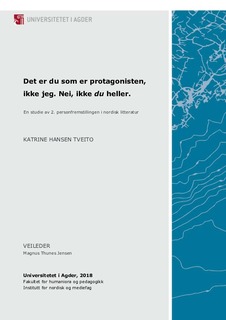| dc.contributor.author | Tveito, Katrine Hansen | |
| dc.date.accessioned | 2018-10-01T07:55:16Z | |
| dc.date.available | 2018-10-01T07:55:16Z | |
| dc.date.issued | 2018 | |
| dc.identifier.uri | http://hdl.handle.net/11250/2565352 | |
| dc.description | Masteroppgave nordisk språk og litteratur NO500 - Universitetet i Agder 2018 | nb_NO |
| dc.description.abstract | In this master thesis I do a text-imaging, narratological and thematic analysis via a
comparative method. I analyse 16 texts in the novel genre and short story genre, in
relation to the use of second-person narration. I analyse the texts in relation to how the
narrator is located locally and temporally in the second-person narration, and how the
second-person narration is used to support certain themes. I have divided the analysis
into two, where I analyse the genres individually in terms of the genre's premise. I have
rendered key points of the field of second-person narration and tested the theory from
prominent researchers within the field, Monika Fludernik, Brian Richardson, Irene
Kacandes, Helmut Bonheim and Rolf Reitan respectively.
A key finding in the thesis is that the theory of the field requires an update. In the years
after the theory has been summarized, many new texts have been published that use a
second-person narration, and these often use the technique differently from what has
been defined in the theory. The narrative theory also has its short comings on certain
points. The previous research of the field has mostly focused on the narrator, but in the
analysis, I have discovered a very interesting aspect of how this form of narration is used
to support a specific theme in the text.
The form of narration is widely used to give the impression that the protagonist has an
external feeling to himself and his surroundings, by telling his own story and actions in
you-form. In these texts, the discourse itself creates an expression of exclusion, which I
claim is distinctive to the second-person narration. This technique is also particularly
prominent in texts that alternate between different narrations and in short story texts.
In the analysis I have tested the question "Who is narrating?" on all the texts and this has
proved difficult to answer. In a second-person narration there is a lot of uncertainty
surrounding the narrator, and it is often manifold. As a reader of a text in second-person
narration, one can both feel addressed and still understand that it is the protagonist who
is being addressed. | nb_NO |
| dc.language.iso | nob | nb_NO |
| dc.publisher | Universitetet i Agder ; University of Agder | nb_NO |
| dc.rights | Attribution-NonCommercial-NoDerivatives 4.0 Internasjonal | * |
| dc.rights.uri | http://creativecommons.org/licenses/by-nc-nd/4.0/deed.no | * |
| dc.subject | NO500 | nb_NO |
| dc.title | Det er du som er protagonisten, ikke jeg. Nei, ikke du heller : En studie av 2. personfremstillingen i nordisk litteratur | nb_NO |
| dc.type | Master thesis | nb_NO |
| dc.subject.nsi | VDP::Humaniora: 000::Språkvitenskapelige fag: 010::Nordiske språk: 018 | nb_NO |
| dc.subject.nsi | VDP::Humaniora: 000::Litteraturvitenskapelige fag: 040::Nordisk litteratur: 042 | nb_NO |
| dc.source.pagenumber | 110 s. | nb_NO |

